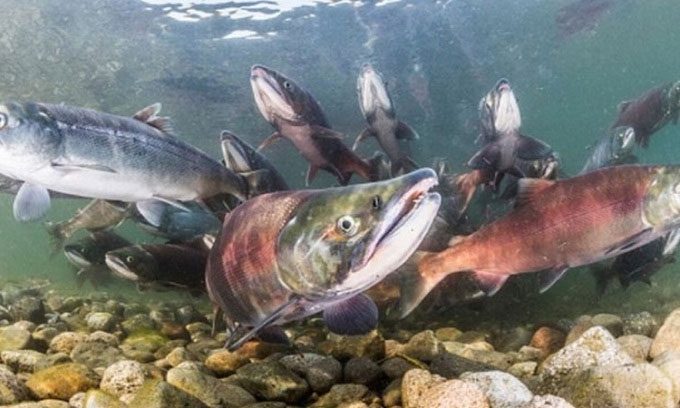Authorities hope to prevent pink salmon from taking over rivers in England by utilizing facial recognition technology commonly found at border checkpoints.
Wildlife experts are concerned that pink salmon, also known as humpback salmon, are establishing breeding populations in England’s waterways, competing with native Atlantic salmon, according to the Telegraph. This summer, a team of experts from the Atlantic Salmon Trust conservation organization will travel to Norway to learn about technologies to combat invasive pink salmon.

Pink salmon threaten to disrupt the ecological balance in England’s river systems. (Photo: Aberdeen Live).
Norway is facing a similar issue as England. The number of pink salmon in the country was 100,000 in 2021 but is projected to increase to one million by 2023, causing significant damage to the local food chain, introducing diseases, and disrupting the natural balance of the native ecosystem. Norway is tackling the problem by deploying river barriers equipped with artificial intelligence (AI) that only open for Atlantic salmon. The AI filtration system in Norway’s Storelva River records fish as they swim upstream, directing invasive pink salmon into a containment area and releasing them back into the sea.
“If the system is suitable and effective, we may consider using it. Pink salmon is a real threat that we are preparing to face,” shared Mark Bilsby, CEO of AST. The AI system in Norway, developed in collaboration with Huawei, has been trained using thousands of images of Atlantic salmon, brown trout, and pink salmon to distinguish between invasive species with 90% accuracy.
Pink salmon are often easily distinguishable from Atlantic salmon, especially when mature and during spawning conditions, when males develop a large hump on their backs. They have a blue-silver or blue-green back with large black spots along their back, fins, and tail. Pink salmon typically measure 40 to 60 cm, much smaller than native species. Females also possess small spots on their fins and have a pink-brown coloration on their sides. The AI system is highly skilled at detecting differences that humans may overlook.
Pink salmon are native to the Pacific coast of Russia and North America, introduced to European rivers in the 1950s as a food source, and have since spread to the northern Atlantic. Like Atlantic salmon, they begin their two-year lifecycle in freshwater, then migrate to the ocean, returning to rivers to spawn. Before 2015, there were only a few pink salmon in rivers in England, but since then, authorities have recorded nearly 200 individuals and are concerned about the risk of invasion this year. The Scottish Environmental Protection Agency will also conduct DNA testing in rivers this summer to determine the extent of their spread.
Native salmon are under significant pressure from climate change, pollution, fish farming, and many other issues. Pink salmon also aggressively defend their nests, potentially attacking and competing for food sources, which can impact the migration patterns of native salmon.




















































